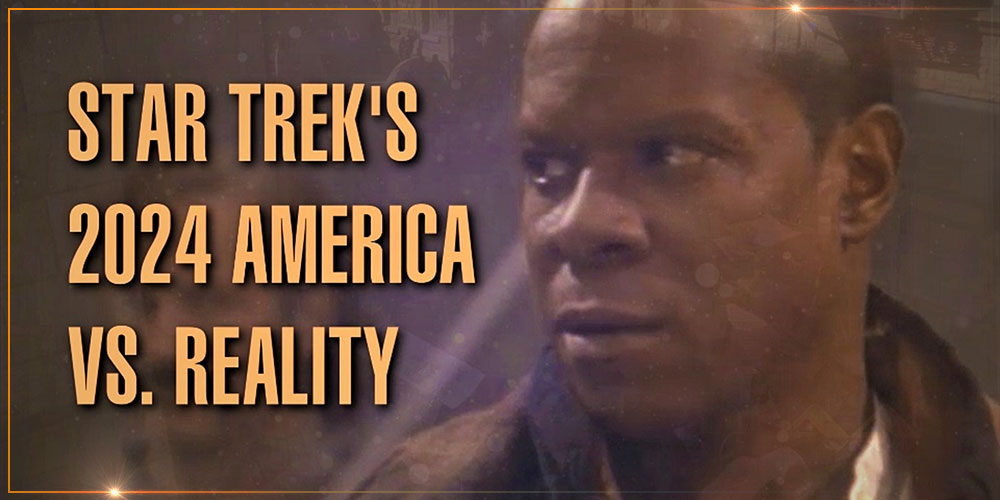Star Trek has often presented scenarios that serve as metaphors or commentaries on current social issues. This is no different in the two-part Deep Space Nine episode “Past Tense.” Depicting a (more) dystopian version of the United States in 2024, “Past Tense” demonstrates what could happen if America gives up on trying to address poverty.
Quickly, I’ll recount the events of the episodes to provide background (warning: spoilers for this 1994 TV show ahead). After a transporter accident displaces Commander Sisko, Dr Bashir, and Lieutenant Dax in 21st century San Francisco, Sisko and Bashir are taken into police custody for lacking ID while Dax is found by Chris Brynner, an entrepreneur who licenses multiple communications technologies. Sisko and Bashir are processed at a facility within Sanctuary District A—one of several districts throughout major U.S. cities designed to house the homeless and financially destitute, but not criminals.
As the two try to plot an escape, Bashir observes the disturbing amount of Sanctuary District residents who require attention for physical and mental ailments but are not receiving it. Sisko reminds the Doctor of the impending Bell Riots, a civil disturbance in District A that serves as a watershed moment for social reforms in the U.S. After the Riots’ namesake, Gabriel Bell, is inadvertently killed, Sisko must take his place in history to ensure the timeline is not shattered. Dax also succeeds in getting Brynner to override the District’s block on outgoing internet broadcasts so Sanctuary residents can share their plight. After this, the Starfleet officers are successfully returned to the 24th century with history intact.
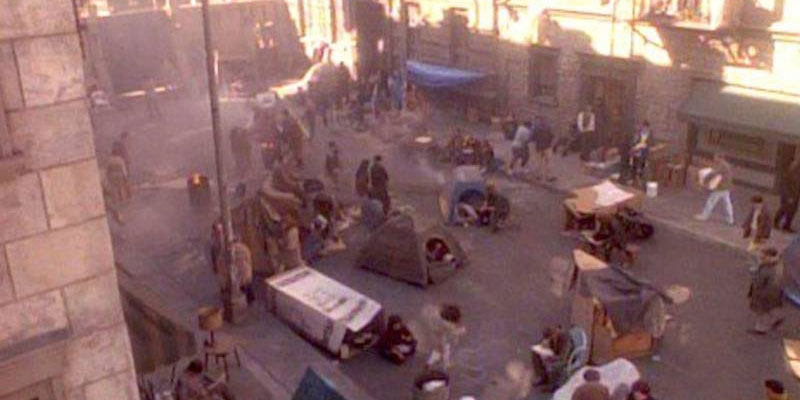
Obviously, this summary leaves out quite a few details. But what I’d like to do here today is examine how the Sanctuary Districts came to be and how that correlates to trends we see in real life. In the episode, the processing agent at the District describes how the world is currently in the midst of an economic depression or at least a shaky recovery. This is reminiscent of developments we’ve seen lately with the public struggling in the wake of the Great Recession and, currently, during the COVID-19 pandemic. Despite large financial institutions bouncing back from economic contractions, the people find themselves with continuously stagnating wages amid higher inflation.
The trend of responding to economic recessions with austerity has its roots early in American history, but the recent use of austerity came as part of Ronald Reagan’s supply-side economic reforms in the 1980s. Since then, most presidents have responded with cuts to social programs that assist the poor and needy, although the past two recessions have seen relatively large stimulus bills passed to directly aid Americans. However, in both instances, most of the benefits have still gone to the wealthy and corporations, with working-class people still living paycheck to paycheck.
Similar trends appear to have happened in the Star Trek universe, albeit to a seemingly greater degree even by the 2020s. However, it still doesn’t necessarily explain how every major city in America decided to lump thousands of citizens into what are effectively ghettos—cordoned off from the rest of the city so wealthier citizens don’t have to even look at the poorest members of society. This is more than just government housing for the unfortunate—the Sanctuary Districts are like prisons that people are forced into, and getting out is nearly impossible. But were they always this way?
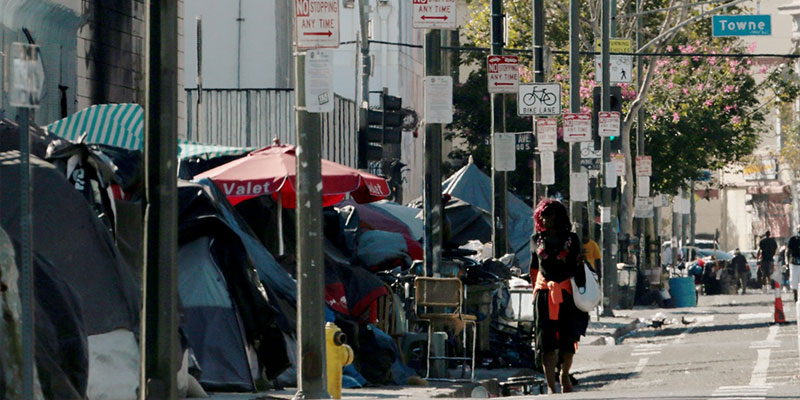
It’s never explicitly stated when the Sanctuary Districts were erected, but it’s possible they originated as a well-intentioned late 20th/early 21st-century solution to poverty and homelessness. At the time “Past Tense” was being filmed, an article appeared in the Los Angeles Times describing a proposal by Mayor Richard Riordan to move homeless people into fenced-in areas; this was in an effort to “make downtown Los Angeles friendlier to business.” Shortly thereafter, the L.A. city council considered setting up “Sanctuaries” in the city for the purpose of removing homeless people from the streets. The city later backed off such proposals. Many of the cast and crew of DS9 would later note how prescient this sequence of events proved to be.
Perhaps in the Star Trek universe, Los Angeles and other cities actually went through with these efforts in the early 1990s, slowly paving the way for what we see in the episode. Some have speculated that the Eugenics Wars could also have played a part—although the exact nature of combat in the Eugenics Wars is still uncertain, with much of it seeming to have taken place on the other side of the world, Trek’s the United States might have a higher veteran population, and thus a higher homeless veteran population. In the aftermath of the September 11th attacks, which we see still happened in the Trek universe, the increased surveillance state and attacks on civil liberties could lay the groundwork for criminalizing lack of ID.
The economic and political fallout of the Great Recession in both timelines also paves the way for a society that pays less attention to its poor. As income inequality and political polarization are exacerbated, political attempts to earnestly combat poverty become less and less frequent. The combination of austerity and automation leads to more joblessness, homelessness, and crime as citizens act out of desperation. At first, many people would voluntarily flock to the districts due to the promise of better job opportunities. But the negligence that pervades the Sanctuary Districts, particularly overcrowding, would grow rampant.
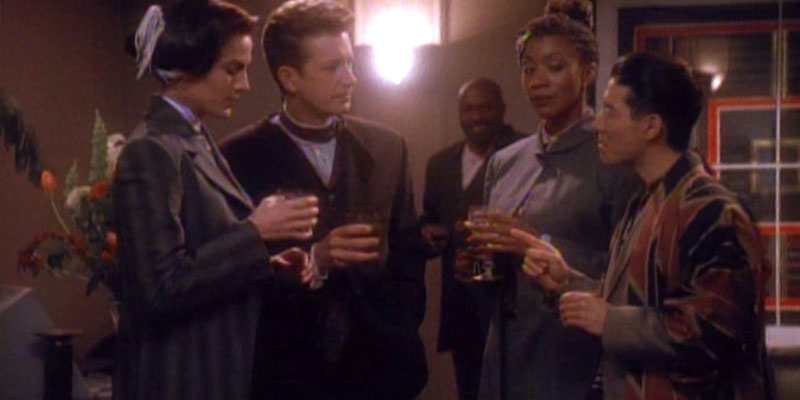
While at a time the Sanctuary Districts might have been seen as a legitimate way to tackle homelessness, and seemingly are seen that way by many in “Past Tense” before the Bell Riots, it becomes clear that the huge flaws in the Sanctuary system are too much to bear. Lack of media coverage of the police brutality and destitute conditions in the Districts is directly addressed by the citizens themselves, who use interfaces connected to Channel 90 on the Internet to tell their stories. The interfaces, provided by a service of Brynner Information Systems, possibly point to a lack of net neutrality in Trek’s 2024 America.
While some have speculated that the Sanctuary Districts could be related to “Sanctuary Cities” in real life, my suspicion is that the two might have little to do with each other, as I do not believe immigration is of the central themes evident in the episodes. Rather, I think that the Sanctuary Districts are slowly but naturally emerging portions of a city designed mainly for optics. As a Sanctuary District is erected, it allows society to wash its hands of the problems that led the District residents to become impoverished in the first place. This, along with the Governor’s unwillingness in the episode to abolish the Districts immediately to quell unrest, is indicative of an incremental approach to problem-solving that plagues both major political parties in the U.S. today. Thus, I could see the events of “Past Tense” happening under just about any federal administration.
It’s possible as well that the impact of the coronavirus on both the economy and the U.S. healthcare apparatus may have fueled the fire when it comes to exposing the flaws in the Sanctuary District system. Of course, there obviously was no way to predict that such a thing would occur as far back as the episode was written, and the butterfly effect may have precluded the COVID outbreak from happening in the first place. But the timing of our current global recession is at least noteworthy. In any case, the atmosphere created for the Bell Riots does seem to mirror many of the trends we are witnessing in our world. At the end of the day, it seems to boil down to the power differences between rich and poor and the indifference among those in power to do the right thing.
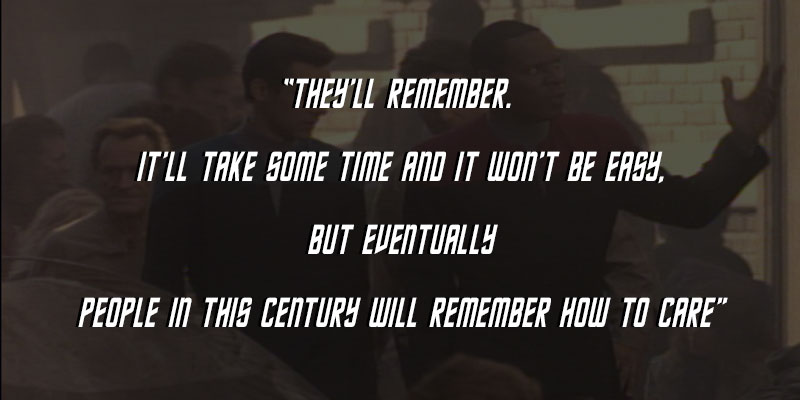
So, what are some of the social reforms that actually occur as a result of the Bell Riots? For one thing, we know that the Sanctuary Districts are eventually abolished and their residents reintegrated into the economy. This is likely aided by political change at multiple levels of government, with leaders responsible for allowing the morose conditions of the Sanctuary Districts voted out and new leaders voted in. As some have pondered on the Daystrom Institute subreddit, the absence of the Bell Riots might have led to a U.S. that was less prepared for World War III, which is why Miles O’Brien comments on the extremely dark conditions he and Kira witnessed when visiting the alternate version of 2048.
There are a couple lines that stand out for me in this episode. One of them is the exchange between Bashir and Lee, the Admin Services official for Sanctuary District A. Bashir says, “It’s not your fault things are the way they are,” to which Lee responds, “Everybody tells themselves that. And nothing ever changes.” And, there’s the final exchange between Bashir and Sisko. Bashir observes, “You know, Commander, having seen a little of the 21st century, there is one thing I don’t understand: how could they have let things get so bad?” Sisko replies, “That’s a good question. I wish I had an answer.”
This serves, I think, as a metacommentary about how many well-meaning individuals in our current society express apathy about social and political change—an apathy that reaches all the way from the top administrative officials in our government down to the average person. It also says something about how many have observed that we might be heading down a path to a similar dystopian reality as the one seen in “Past Tense,” although the episode’s motifs are greatly exaggerated. The silver lining, though, is that even in the episode’s dystopia, acts of bravery can still lead to positive change.
In the meantime, thanks for watching! I definitely want to hear your thoughts in the comments. If you enjoy content like this, becoming a patron HERE… It is a great way to support me.
Watch The Latest Video By Orange River Media Below
Don’t forget to subscribe, and I’ll see you next time! Live long and prosper…
You can find Orange River Media at the links below
- YouTube: https://www.youtube.com/orangeriver
- Twitter: https://www.twitter.com/orangerivernw
- Instagram: https://www.instagram.com/orangeriver.nw
- Facebook: https://www.facebook.com/orangerivernw
- Patreon: https://www.patreon.com/orangeriver

